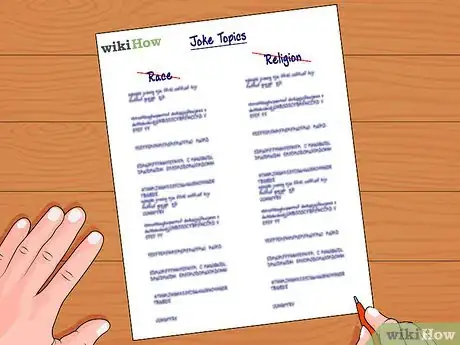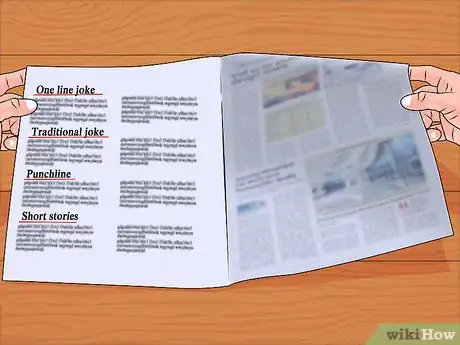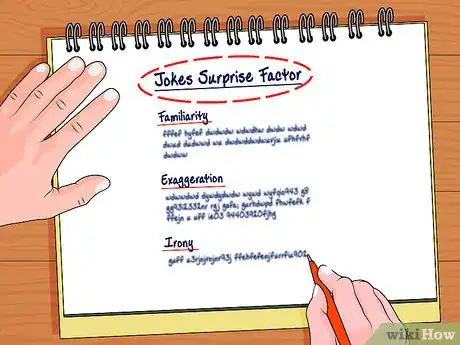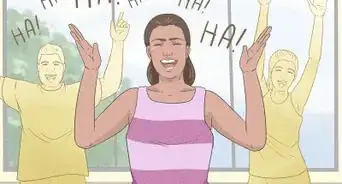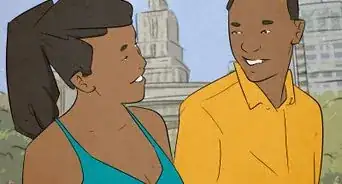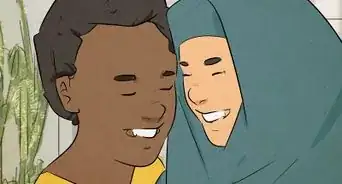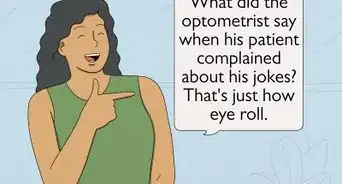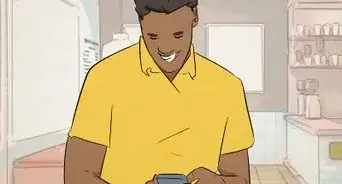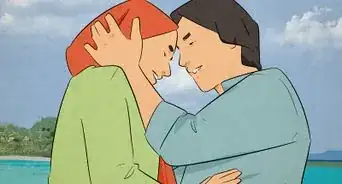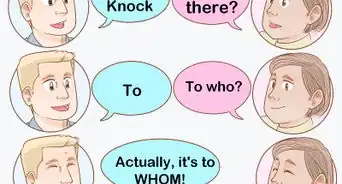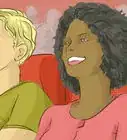This article was co-authored by Kendall Payne. Kendall Payne is a Writer, Director, and Stand-up Comedian based in Brooklyn, New York. Kendall specializes in directing, writing, and producing comedic short films. Her films have screened at Indie Short Fest, Brooklyn Comedy Collective, Channel 101 NY, and 8 Ball TV. She has also written and directed content for the Netflix is a Joke social channels and has written marketing scripts for Between Two Ferns: The Movie, Astronomy Club, Wine Country, Bash Brothers, Stand Up Specials and more. Kendall runs an IRL internet comedy show at Caveat called Extremely Online, and a comedy show for @ssholes called Sugarp!ss at Easy Lover. She studied at the Upright Citizens Brigade Theatre and at New York University (NYU) Tisch in the TV Writing Certificate Program.
There are 9 references cited in this article, which can be found at the bottom of the page.
This article has been viewed 436,493 times.
One of the best ways to make people laugh is by telling a joke or a funny story. Studies show that jokes and laughter can decrease stress and ease tension.[1] Good jokes can also break the ice in awkward situations. But getting people to laugh requires writing good jokes. With these tips, practice, and remembering to have fun, your good jokes will give many people a good laugh!
Things You Should Know
- The key is to find great material while avoiding controversial topics. For example, your own life is great inspiration, but religious topics are not.
- Write an effective set up and punchline. Lead your audience into the joke with a few details, then come up with a hilarious finish.
- Go big on facial expressions and hand gestures to spice up your delivery. Visual cues can make a good joke great!
Steps
Preparing
-
1Consider interesting joke material. Writing about topics that interest not only you, but also your intended audience is an important component of ensuring that people will find you and your jokes funny.
- Consider the types of jokes or comedians who make you and your friends or colleagues laugh. Having an idea of jokes that elicit laughter will point the way to finding optimal joke material.
- It's a good idea to think about material for different situations and audiences so that you can tailor your jokes to them. For example, a joke you deliver to break the ice at a job interview (“How much does a polar bear weigh? Enough to break the ice!”) will not be the same as a joke at a family party (“What did the cake say to the knife? You wanna piece of me?”)[2]
-
2Research topics for different situations and audiences. You'll want to tailor your jokes for any place or group of people you might encounter. This way, you're more likely to have people understand your joke and laugh at it. Tailoring the material also ensures that you are less likely to offend someone. For example, a joke delivered to a group of medical professionals isn't necessarily appropriate for a group of historians or political scientists.
- Topics such as current events, celebrities, or even yourself (known as self-deprecating humor) make excellent joke material. You can find funny material for jokes in almost every situation.[3] For example: Public figures and their behavior often find themselves the butt of jokes. Comedian Chris D'Elia joked of singer Justin Bieber "You have it all: except love, friends, good parents and a Grammy."
- Newspapers, magazines, or even situations in your own life make excellent joke topics. For instance, you could make a joke about having a “black thumb” with plants: “I bought a cactus. A week later it died. And I got depressed, because I thought, Damn. I am less nurturing than a desert.”[4]
- Watching famous comedians deliver their jokes during an act is another good source of material. It will also show you how to effectively deliver a joke.
Advertisement -
3Try to avoid controversial topics that might offend someone. There are certain topics that are taboo and probably aren't good material in most situations.
- Jokes about topics such as race and religion are likely to offend many people. While it might be acceptable in some situations, such as among family members, to make off-color jokes, it's best to leave controversial topics off the table for other forums.
- If you're unsure about if your topic or joke will offend someone, it's best to err on the side of caution and leave it out.
Writing
-
1Consider your joke structure. There are a couple of different ways to write and deliver jokes including the traditional set up and punchline, one-liners, or short stories. [5]
- One liners can be an extremely effective format. Comedian BJ Novak made the simple and effective, if tasteless, one-liner: “Battered women: sounds delicious.” Novak's joke plays on two elements you can incorporate into your material: surprise and twisting word meanings. It's also a traditional set up and punchline type of joke.[6]
- Jokes as a short story are another effective method. However, remember to keep them short! A good example of a joke wrapped in a short story is: “There was once a young man who, in his youth, professed a desire to become a "great" writer. When asked to define "great" he said "I want to write stuff that the whole world will read, stuff that people will react to on a truly emotional level, stuff that will make them scream, cry, wail, howl in pain, desperation, and anger!" He now works for Microsoft writing error messages.”
-
2Write the set up and punchline. Every joke, no matter what structure you use, has a set up and a punchline. The set up and punchline will sometimes contain elements of surprise based on assumptions, twisting words, or playing on ironies.[7]
- Remember "less is more." As you prepare your set up and punchline, remember that you will want to tell your joke in as few words as possible. Avoid unnecessary details and phrases.[8] BJ Novak's joke “Battered women: sounds delicious” and the joke “What did the cake say to the knife? You wanna piece of me?” are examples of jokes that demonstrate the “less is more” strategy. Any other details would have caused the jokes to fall flat.[9]
- Your set up should be one or two lines, or a few lines for a story. It prepares your audience by creating an expectation and giving them the details they need to understand the punchline. The joke about the dead cactus is a good example of this. The comedian sets up the joke with the lines “I bought a cactus. A week later it died.”[10]
- The punchline is the “funny” part of your joke that will make people laugh. It builds on the set up and is only one word or one sentence. It often reveals the surprise, irony, or word play to your audience. Again, the dead cactus joke is a good example of a short and funny punchline. After setting up the audience with the details of his plant cactus, the comedian tells us: And I got depressed, because I thought, Damn. I am less nurturing than a desert.” .”[11]
-
3Heighten the joke's surprise factor. Elements such as familiarity, exaggeration, and irony will enhance your joke.
- A good example of exaggeration and irony is the story about the young man with great aspirations. Most listeners will expect that he fulfilled his wish to write “stuff that people will react to on a truly emotional level, stuff that will make them scream, cry, wail, howl in pain, desperation, and anger!" through novels or short stories. Instead, the surprise is that “He now works for Microsoft writing error messages.”
-
4Add tags or toppers. Tags and toppers are additional punchlines that build upon your first punchline.
- You can use tags and toppers as a way to get extra laughs without writing a new joke or needing to set up any material. For example, you could add a topper to the short story by saying “In fact, he's the one screaming, crying, wailing, and howling in pain the most.”
-
5Practice your joke. Before you tell your joke to friends or any audience, practice delivering it.[12]
- You'll need to find the joke funny for your audience to feel the same! If you don't find the joke funny or somehow off, revise it until it works for you.
Delivering
-
1Consider your audience. Before you tell one of the jokes you've written, think about who your audience is. This will help guarantee that they understand your joke and increase the likelihood of laughter. A group of elderly people probably wouldn't get the joke about Justin Bieber because he is a young pop star with a very young fan base.[13]
- You're less likely to offend someone if you know your audience. For example, it's probably not advisable to tell the joke about “battered women” to a women's group.
-
2Add gestures. Think about what facial expressions or gestures will enhance the set up and punchline(s). Drawing pictures is another effective method to help your audience understand your joke.
-
3Be confident, relax, and improvise if you need to. These visual cues will do the same for your audience and make them more likely to laugh.
- If your audience doesn't laugh you can make a joke about that or move on to other material. You can always revise the joke for future use.
- Remember that even the best comics have jokes that fall flat. John Stewart, Jerry Seinfeld, Bob Newhart and others aren't funny all the time.
Sample Jokes
Expert Q&A
-
QuestionHow can I come up with ideas for jokes?
 Kendall PayneKendall Payne is a Writer, Director, and Stand-up Comedian based in Brooklyn, New York. Kendall specializes in directing, writing, and producing comedic short films. Her films have screened at Indie Short Fest, Brooklyn Comedy Collective, Channel 101 NY, and 8 Ball TV. She has also written and directed content for the Netflix is a Joke social channels and has written marketing scripts for Between Two Ferns: The Movie, Astronomy Club, Wine Country, Bash Brothers, Stand Up Specials and more. Kendall runs an IRL internet comedy show at Caveat called Extremely Online, and a comedy show for @ssholes called Sugarp!ss at Easy Lover. She studied at the Upright Citizens Brigade Theatre and at New York University (NYU) Tisch in the TV Writing Certificate Program.
Kendall PayneKendall Payne is a Writer, Director, and Stand-up Comedian based in Brooklyn, New York. Kendall specializes in directing, writing, and producing comedic short films. Her films have screened at Indie Short Fest, Brooklyn Comedy Collective, Channel 101 NY, and 8 Ball TV. She has also written and directed content for the Netflix is a Joke social channels and has written marketing scripts for Between Two Ferns: The Movie, Astronomy Club, Wine Country, Bash Brothers, Stand Up Specials and more. Kendall runs an IRL internet comedy show at Caveat called Extremely Online, and a comedy show for @ssholes called Sugarp!ss at Easy Lover. She studied at the Upright Citizens Brigade Theatre and at New York University (NYU) Tisch in the TV Writing Certificate Program.
Writer, Director, & Stand-up Comedian I like to take very basic premises and then just find one element to emphasize, dramatize, or elevate. So, for example, people often freak out when you don't answer your phone or respond to text messages, right? So one skit I came up with was all about this person whose phone died, and their friends started overreacting by assuming that they'd died. The humor there comes from that one little amplification! You don't need to come up with something ground-breaking every single time. Often, it's just about those little touches or changes.
I like to take very basic premises and then just find one element to emphasize, dramatize, or elevate. So, for example, people often freak out when you don't answer your phone or respond to text messages, right? So one skit I came up with was all about this person whose phone died, and their friends started overreacting by assuming that they'd died. The humor there comes from that one little amplification! You don't need to come up with something ground-breaking every single time. Often, it's just about those little touches or changes. -
QuestionWhat does it mean if a joke gets tons of laugh one time, but not the other?
 Kendall PayneKendall Payne is a Writer, Director, and Stand-up Comedian based in Brooklyn, New York. Kendall specializes in directing, writing, and producing comedic short films. Her films have screened at Indie Short Fest, Brooklyn Comedy Collective, Channel 101 NY, and 8 Ball TV. She has also written and directed content for the Netflix is a Joke social channels and has written marketing scripts for Between Two Ferns: The Movie, Astronomy Club, Wine Country, Bash Brothers, Stand Up Specials and more. Kendall runs an IRL internet comedy show at Caveat called Extremely Online, and a comedy show for @ssholes called Sugarp!ss at Easy Lover. She studied at the Upright Citizens Brigade Theatre and at New York University (NYU) Tisch in the TV Writing Certificate Program.
Kendall PayneKendall Payne is a Writer, Director, and Stand-up Comedian based in Brooklyn, New York. Kendall specializes in directing, writing, and producing comedic short films. Her films have screened at Indie Short Fest, Brooklyn Comedy Collective, Channel 101 NY, and 8 Ball TV. She has also written and directed content for the Netflix is a Joke social channels and has written marketing scripts for Between Two Ferns: The Movie, Astronomy Club, Wine Country, Bash Brothers, Stand Up Specials and more. Kendall runs an IRL internet comedy show at Caveat called Extremely Online, and a comedy show for @ssholes called Sugarp!ss at Easy Lover. She studied at the Upright Citizens Brigade Theatre and at New York University (NYU) Tisch in the TV Writing Certificate Program.
Writer, Director, & Stand-up Comedian Was your delivery different? Often, the way you tell a joke is just as important as the content of your joke. It could also be that your audience was different. Everyone has a unique sense of humor and it's possible for a joke to play well with one crowd but not another.
Was your delivery different? Often, the way you tell a joke is just as important as the content of your joke. It could also be that your audience was different. Everyone has a unique sense of humor and it's possible for a joke to play well with one crowd but not another. -
QuestionWhy do I always get writers block, but when I perform it's so easy?
 Community AnswerTry performing to yourself or to an audience in your head while you're writing. You even get to choose any venue you like!
Community AnswerTry performing to yourself or to an audience in your head while you're writing. You even get to choose any venue you like!
References
- ↑ http://www.mayoclinic.org/healthy-living/stress-management/in-depth/stress-relief/art-20044456
- ↑ http://www.harrytheclown.com/jokes.html
- ↑ http://www.theguardian.com/books/2008/sep/22/comedy
- ↑ http://nymag.com/nymetro/arts/features/14578/
- ↑ http://www.standupcomedyclinic.com/how-to-write-a-joke-2/
- ↑ Kendall Payne. Standup Comedian. Expert Interview. 3 April 2020.
- ↑ Kendall Payne. Standup Comedian. Expert Interview. 3 April 2020.
- ↑ http://www.jimrichardson.com/write.shtml
- ↑ http://www.harrytheclown.com/jokes.html
- ↑ http://nymag.com/nymetro/arts/features/14578/
- ↑ http://nymag.com/nymetro/arts/features/14578/
- ↑ Kendall Payne. Standup Comedian. Expert Interview. 3 April 2020.
- ↑ Kendall Payne. Standup Comedian. Expert Interview. 3 April 2020.
About This Article
To write a good joke, start by writing a 1 to 2 line set up to prepare your audience for the joke. For example, a set up could be "How much did the polar bear weigh?" Then, write a 1 word or 1 sentence punchline that will reveal the surprise, irony, or word play to your audience. For example, if your set up was "How much did the polar bear weight?" your punchline could be “Enough to break the ice!” Before performing your jokes, practice them so you don’t need to read them off a paper. To learn how to find material for your jokes, keep reading!


